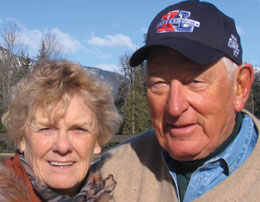In this issue
Home page
-
Features
-
Departments
- Letters
- News & Notes
- Parents
- Alumni
- Class Notes
- Giving
- Sports
- Aggies Remember
- End Notes
Third floor Mrak Hall
University of California, Davis One Shields Avenue Davis, CA 95616(530) 752-1930
Volume 27 · Number 2 · Winter 2010
Aggies Remember
Life in the old hog barn
For a city boy, some valuable teachers were porcine.
By Ian Coster ’54, D.V.M. ’58
When I came to UC Davis in 1953, jobs and reasonable housing were in short supply, so when someone in the housing office said a live-in job was available at the hog barn, I jumped at it.
The next year living in the barn was one of learning and delight for a city boy who had spent three years at that huge degree factory known as UCLA. I had not had any close association with pigs or any other large animals, other than the occasional horse, so everything about my job was brand new. By the end of the year I knew every sow by name, had helped them bring their squealing little children into the world on dark nights when nobody else seemed to exist for miles, and learned what bright and pleasant creatures pigs could be. Contrary to public opinion, they are not messy, dirty, creatures. They do like mud, however.
UC Davis at that time only had one herd boar, named Boris. My room was on the second story of the barn, and one morning I got up to see what I thought was Boris’ isolated head lying on the ground. I leapt out of bed in terror and ran downstairs to find that someone had left a hose running in his outside enclosure (he was the only pig with a dirt pen). During the night Boris had succeeded in immersing himself completely in the mud. When he saw me he gave a contented grunt as much as to say, “Join me, this is great!”
Boris also had another little habit that caused a lot of trouble. He was an escape artist. The barn was built in 1913, and most of the fences around it, I suspect, were of the same age and quite weak. All Boris had to do was to put his 600-pound bulk against the planks and push — and he was free. He would then trot down to the Putah Creek bridge and lie smack down in its middle. In warm weather, the bridge stayed cool from the water running below. In the morning, the honking of horns by blocked drivers let me know that Boris was there.
The professor responsible for the hog barn and all the goings-on therein was Hubert Heitman. He was a wonderful, kind man who really loved pigs. He would take a genuine interest in the pigs as individuals, not just as research tools, and he especially liked Boris. In fact, during breeding season he would come down to the barn and personally urge him on during the main activity for which Boris existed.
Another frequent visitor to the barn was Jack Howarth, a professor of veterinary medicine who would come down to the barn to get blood samples from the porkers for some project or other. Anybody handy would be expected to help tip a 200-pound pig upside down so Professor Howarth could stick a 4-inch needle into its anterior vena cava that returns blood to the heart, the only vein in a pig where it is possible to get a large blood sample.
Needless to say, the pig was not keen on this procedure, and would scream at the top of his lungs from the second he was upended, not from pain, but from fury. Afterward, I could not hear anything for hours. I am happy to say Professor Howarth was on the vet school admissions board. Apparently he thought anybody who would live in the hog barn for a year really wanted to be a vet, and voted to let me in.
At night, my nearest human neighbor was a quarter mile away in the old sheep barn. Sometimes I would get lonely enough to go down and talk to the pigs and scratch their backs. They would grunt in response; that was enough. Despite my anxiety over getting grades good enough to get into vet school, the year passed quickly and pleasantly, and I wouldn’t trade that time for any other.
Editor: The old hog barn was closed as an agricultural building in 2002, when the swine program moved to a new facility west of Highway 113. Then, in 2004, to make room for the Mathematical Sciences Building, the barn was moved to where it is today: south of the Silo. After a renovation, it reopened last year as the Hubert Heitman Jr. Staff Learning Center, with offices and classroom space for Staff Development and Professional Services. Swine facility manager Kent Parker says the new swine center was stocked with high-health-status pigs from Kentucky. But before that, durocs had a long lineage in the UC Davis herd. “The old Hog Barn had duroc pigs continuously until it was closed in 2000. I am sure the last red pigs to leave were descendants of Boris.”

After running a veterinary practice in Santa Monica for 40 years, Ian Coster ’54, D.V.M. ‘58 retired in 1990 with his wife, Pat, to Lake Hughes, where they have a ranch with some horses — but no pigs. Smelling like the hog barn used to be hard on his social life, Coster recalls.
